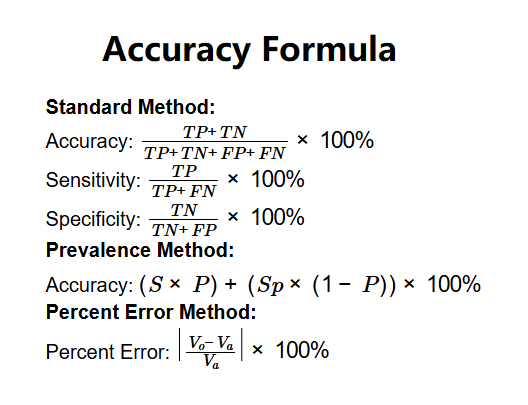1. What is an Accuracy Calculator?
Definition: This calculator computes the accuracy of a test or measurement using three methods: Standard, Prevalence, and Percent Error. Accuracy shows how close a result is to the true value. The Standard method uses a confusion matrix, Prevalence accounts for disease prevalence, and Percent Error compares observed and accepted values.
Purpose: It is used in medical diagnostics, statistical analysis, and experimental measurements to evaluate test reliability or measurement precision, aiding in research, quality control, and clinical decisions.
2. How Does the Calculator Work?
The calculator uses these formulas:
- Standard Method:
- Accuracy: \( \frac{TP + TN}{TP + TN + FP + FN} \times 100\% \)
- Sensitivity: \( \frac{TP}{TP + FN} \times 100\% \)
- Specificity: \( \frac{TN}{TN + FP} \times 100\% \)
- Prevalence Method:
- Accuracy: \( (S \times P) + (Sp \times (1 - P)) \times 100\% \)
- Percent Error Method:
- Percent Error: \( \left| \frac{V_o - V_a}{V_a} \right| \times 100\% \)
Steps:
- Choose a method (Standard, Prevalence, or Percent Error).
- Standard: Enter True Positive (\( TP \)), False Negative (\( FN \)), False Positive (\( FP \)), True Negative (\( TN \)).
- Prevalence: Enter Prevalence (%), Sensitivity (%), Specificity (%).
- Percent Error: Enter Observed Value (\( V_o \)), Accepted Value (\( V_a \)).
- Validate: Inputs must be non-negative; Prevalence, Sensitivity, Specificity between 0% and 100%; Accepted Value not zero.
- Compute results using formulas.
- Show outputs to 2 decimal places.
3. Importance of Accuracy Calculations
Accuracy calculations are key for:
- Medical Diagnostics: Checking test reliability for accurate disease detection.
- Scientific Research: Validating measurements against standards.
- Quality Control: Ensuring tools are calibrated in industries like manufacturing.
4. Using the Calculator
Examples:
- Example 1 (Standard): \( TP = 80 \), \( FN = 20 \), \( FP = 10 \), \( TN = 90 \)
- Accuracy: \( \frac{80 + 90}{80 + 90 + 10 + 20} \times 100 = 85.00\% \)
- Sensitivity: \( \frac{80}{80 + 20} \times 100 = 80.00\% \)
- Specificity: \( \frac{90}{90 + 10} \times 100 = 90.00\% \)
- Example 2 (Prevalence): Prevalence = 30%, Sensitivity = 80%, Specificity = 90%
- Accuracy: \( (0.80 \times 0.30 + 0.90 \times 0.70) \times 100 = 87.00\% \)
- Example 3 (Percent Error): Observed Value = 92°F, Accepted Value = 95.6°F
- Percent Error: \( \left| \frac{92 - 95.6}{95.6} \right| \times 100 = 3.77\% \)
5. Frequently Asked Questions (FAQ)
Q: What is the difference between accuracy and precision?
A: Accuracy measures closeness to the true value; precision measures consistency of repeated measurements.
Q: When should I use the Prevalence method?
A: Use it when the sample's disease ratio differs from the population's actual prevalence.
Q: Can accuracy be 100%?
A: Yes, but rare due to real-world test or measurement limitations.
 Home
Home
 Back
Back
